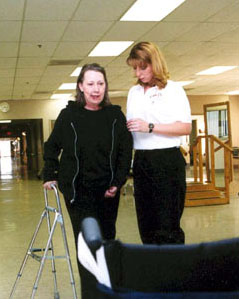PICAYUNE, Miss.—Nona Fleming says she believes in miracles.
After surviving a ruptured brain aneurysm and coming out of a five-week-long coma, Fleming is walking and talking at home after her recent release from Methodist Rehabilitation Center in Jackson.
“Most people don’t make it through an aneurysm like mine and most people don’t make it through a coma after five weeks. I’m a double miracle,” said the 54-year-old Picayune resident.
Her family and the health care professionals who worked with her agree.
“It was scary,” recalls her daughter Kara Fleming. “We were with my sister at a dance contest when we realized that mom looked pale and disoriented.”
At first, the sisters suspected their mother’s blood pressure had fallen, but they soon realized the condition was more serious. An ambulance took her to a nearby hospital where a neurosurgeon found bleeding in her brain, the result of a ruptured aneurysm.
Studies show that about 3 to 5 percent of the United States population has brain aneurysms, which are weak bulging spots in an artery. They are most common in people ages 35 to 60, and women are more likely to get brain aneurysms than men.
Symptoms of a brain aneurysm include a localized headache, nausea and vomiting, stiff neck or back pain, blurred vision or double vision, pain above and behind the eye, dilated pupils and sensitivity to light. However, many people never experience any symptoms until their brain aneurysm ruptures, causing devastating damage. The Brain Aneurysm Foundation reports that half of the people with ruptured brain aneurysms die within minutes. Half of those who survive suffer a delayed death. And the remaining survivors often live with long-term deficits.
At first, it looked like Nona might be one of the unlucky ones. “When she was first admitted, she was in a semi-comatose state,” said Samuel Gontkovsky, a clinical neuropsychologist at Methodist Rehab. “She could barely open her eyes. Initially, she didn’t respond to stimulation. It’s incredible the gains she has made.”
Dr. Michael Winkelmann, Nona’s physician at Methodist Rehab, said her comeback illustrates the successes that are possible through modern rehabilitative medicine. “If appropriate therapy is given, people do have a good chance to show recovery. The bleed in Nona’s brain just devastated her and left her with little movement in her left side. But with appropriate brain injury therapy and a little drug intervention to improve her arousal, she did very well. When you can transform an otherwise non-functioning patient to someone who can function in the community, that is what brain injury rehabilitation is all about.”
After staying in a coma-like state for more than a month, Nona was mostly unresponsive to therapy when she first arrived at Methodist Rehab.
“She wouldn’t catch herself if she started to fall,” occupational therapist Sarah Riccio recalled. “She couldn’t even hold her head up.”
“Early on, she was unable to communicate or maintain wakefulness,” said her speech therapist Carla Speights. “I would stroke her hand, talk to her and have her make eye contact to keep her awake.”
Once she became more cognizant, though, Nona was determined to get better. She threw herself into daily rounds of occupational, physical and speech therapy to regain her balance, her strength and her communication skills.
Because she was at Methodist Rehab, Nona was able to take advantage of treadmill gait training, a relatively new therapy offered at only about a dozen hospitals in the country. While the treadmill’s harness, pulleys and a pneumatic system supported Nona’s weight, her therapists manipulated her legs in a stepping motion. “Through the treadmill training, we were able to address issues she had with balance and shifting her weight from her left to right side,” said her physical therapist Kimberly Willis.
Nona also played plenty of games of Connect 4 while standing, a ploy to build up her balance and endurance.
During therapy, Nona focused on improving each session. Every step she takes is accompanied by a smile. “I can walk 240 feet now,” she said. “A few weeks ago, I could only walk 30 feet.”
Riccio worked with Nona to regain her independence and her ability to handle daily tasks of living, such as dressing and feeding herself. “Being able to put on her makeup by herself was really important to her, so we worked on that. Now, she’s doing it with one hand,” Riccio said.
Speaking well also was a priority for Nona, who learned from Speights how to exaggerate her words so that she could be understood. Speights also worked with Nona to help her get back her old smile. “We concentrated on increasing the strength and range of motion of her left facial muscles,” Speights said. “And she actually had a much more symmetrical smile when she left.”
And plenty of reason to smile. “Everyone listened to me and worked with me to get better,” said Nona, who had her family deliver king cakes from Paul’s Pastry Shop in Picayune as a way to say thanks to the hospital staff. “They’ve been good to me.”
Caregivers worked with Nona’s family to help ease the transition of living at home again and making sure another aneurysm doesn’t happen. “We have to watch her blood pressure and her diet,” said Kara. “She’s walking now, but we know she needs to do more. Exercise will be important to making sure this doesn’t happen again.”
To that end, her therapists worked with the sisters to show them the best ways to help their mother safely exercise.
The day before her discharge, Nona bowled a score of 85 during a group outing for patients.
“I swear that since she entered Methodist Rehab, her smile has widened,” Kara said. “She is an utter and complete miracle. My mother with her aneurysm and her wheelchair can still bowl better than me.”

